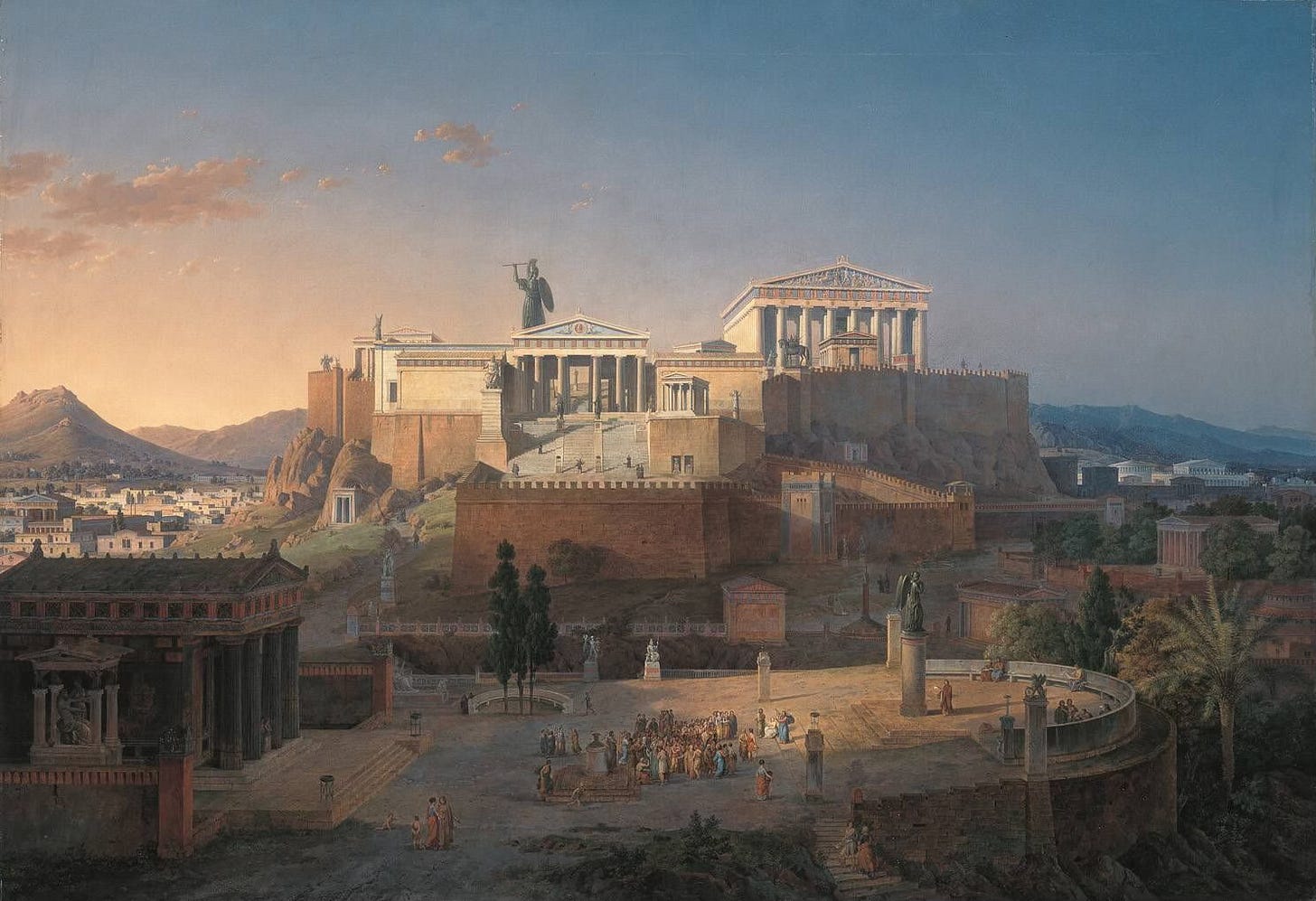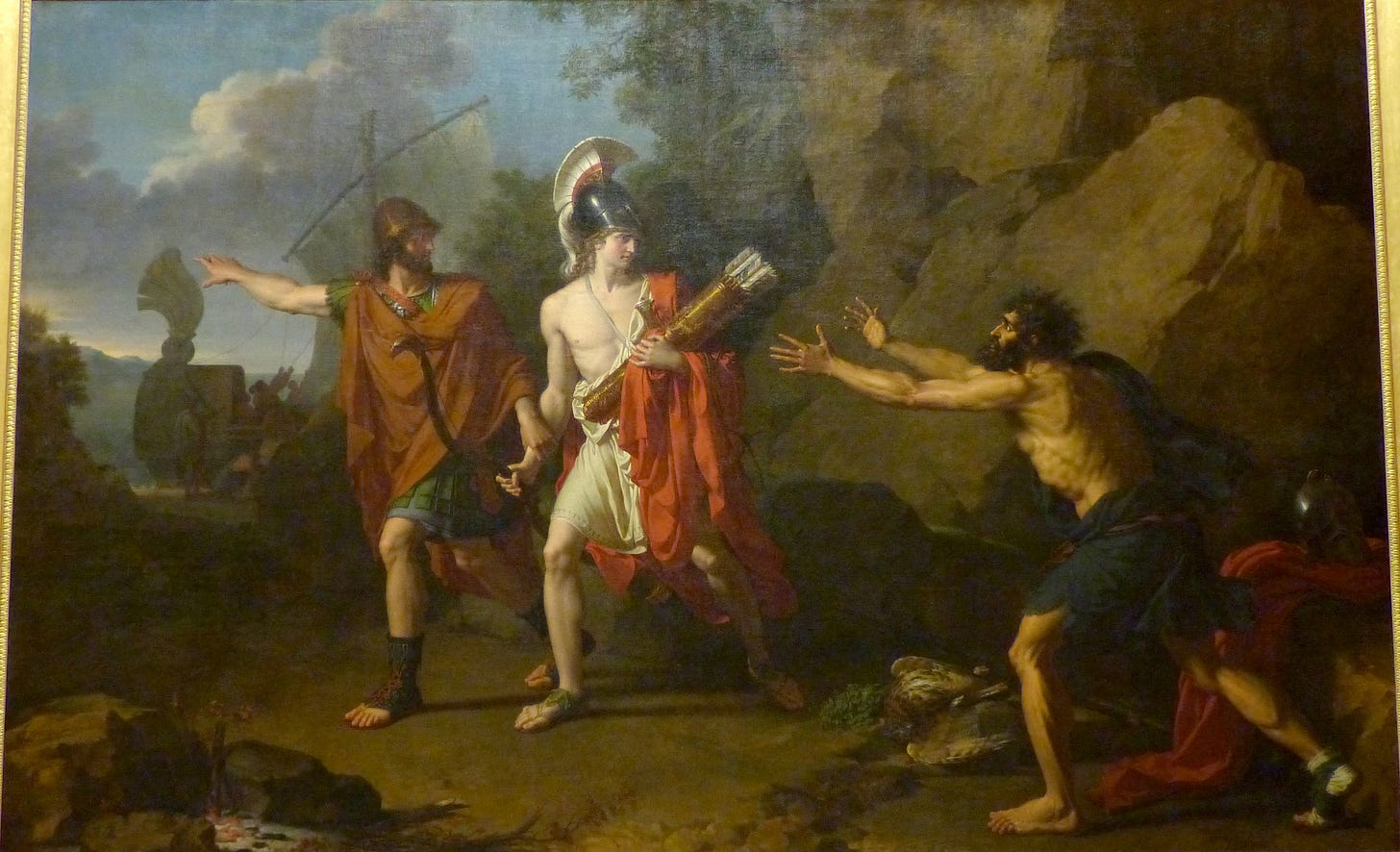Ares vs the Areopagus
Thoughts on the connection between deceit and violence.
In the painting above, the Areopagus is in the foreground with the Acropolis towering behind it. In the third part of Aeschylus’ trilogy, The Oresteia, we learn that the Aeropagus is the place where Athena established law courts and deliberation.
The Areopagus means the rock or hill of Ares. Ares is the god of war and is a son of Zeus. Throughout the Iliad, we see Ares stirring up trouble as a god of force.
There’s a natural comparison between Ares and the Areopagus. Ares covers force, power, and violence. The Areopagus stands for deliberation, discussion, and persuasion. The Greeks viewed the Aeropagus as the way of civilization and the opposite, the way of barbarism. In a way, the hill of Ares is the place where the Greeks transcended violence through deliberation.
I think about these two paths a lot. They show up over and over in Greek literature. For example, in the tragedy play Philoctetes by Sophocles, we see these paths contrasted in a memorable way. There are three main characters in Philoctetes:
Philoctetes - a Greek hero abandoned on the island of Lemnos
Odysseus - the man of twists and turns
Neoptolemus - the son of Achilles
A prophecy tells that the only way the Greeks can defeat the Trojans is through the use of the bow of Heracles, currently in the possession of Philoctetes. Odysseus and Neoptolemus sail to Lemnos in order to convince Philoctetes to return with them to Troy with his famous bow. However, Philoctetes hates Odysseus, and so Odysseus must use the young Neoptolemus to persuade Philoctetes.
Odysseus thinks this persuasion will best be conducted through deceit. Neoptolemus says it’s not in his nature to lie and would prefer honesty. If his first line of persuasion doesn’t work, he can try a second line. If that doesn’t work, he still has the trust of Philoctetes to try again.
In fact, this is exactly what we see in the tragedy play. After Neoptolemus attempts deception and is caught, he comes clean, thus gaining some level of trust from Philoctetes. Neoptolemus then attempts truthful persuasion by appealing to Philoctetes pride and medical healing. It succeeds.
However, there’s a key point in the middle of the tragedy play where the deceit of Neoptolemus has been discovered by Philoctetes and Odysseus says they must now resort to force and violence to get their way. By lying to Philoctetes, Neoptolemus put himself into a bind. Neoptolemus couldn’t lie again since Philoctetes knew he lied the first time. He also couldn’t tell the truth because Philoctetes wouldn’t have believed him. His only alternative is to use force and violence to get his way. Ares vs the Aeropagus.
I think there is a key lesson in this for us today. A lie will eventually lead to violence. That violence may work out in external force or in internal hatred. I’ve started using this as a framework for considering situations. If I see an act of violence, I wonder if there is a lie fueling that force. If I see someone harming themselves, I wonder what lie they believe.
As with any framework, there are limits. I realize I’m painting with broad strokes here. Not every act of force or violence has some lie attached to it. Sometimes, violence results from protection or preservation. But on the first level, we have a choice between Ares or Aeropagus, violence or deliberation. On the second level, in that deliberation, we have the choice between using truth or deception. Deception will lead right back to Ares. Truth will lead to further deliberation. If we as a culture cannot deal in the world of truth and deliberation, falsehood and force will ensue.





